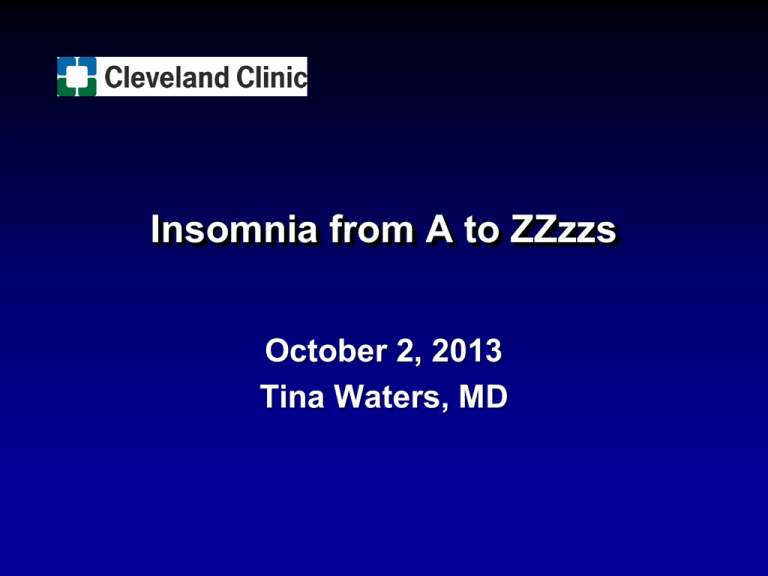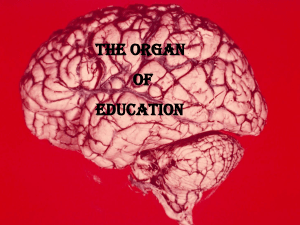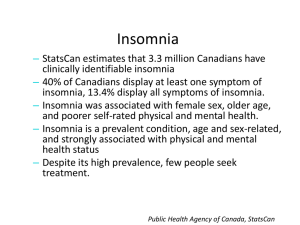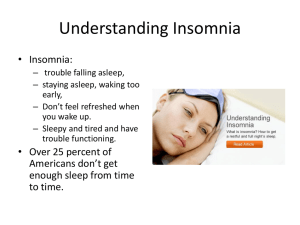
Insomnia from A to ZZzzs
October 2, 2013
Tina Waters, MD
Objectives
• Summarize the basic principals of sleep and
describe normal sleep patterns versus insomnia
• Review the clinical and diagnostic evaluation of
insomnia as well as negative health and social
consequences of sleep loss
• Achieve a basic understanding of the
neurophysiology underlying sleep/wake cycles
and the benzodiazepine receptor site
• Differentiate among sedative hypnotics with
respect to their relative risks, benefits, and
indications
Sleep architecture
Source: National Sleep Foundation (2008)
Two Process Model of Sleep
Process S: Homeostatic sleep drive or sleep
pressure - sleep occurs naturally in response to
how long we are awake; longer awake, the
stronger sleep drive
Process C: Circadian process - this process
controls the timing of sleep and wakefulness
during the day-night cycle. Timing is regulated by
the circadian biological clock that is located in
the brain in the SCN (suprachiasmatic nucleus)
Kilduff TS, Kushida CA. Sleep Disorders Medicine: Basic Science, Technical Considerations,
and Clinical Aspects. 1999; based on Edgar DM, et al. J Neurosci. 1993.
Sleep inertia/ pressure builds over
the course of the day
Normal
Sleep
Helps us go to
sleep at night
Circadian factors keep us awake- drive for wakefulness:
Afternoon lownormal
“second wind” then
down again
NAP
Napping
Less pressure to
sleep at night;
More difficult to fall
asleep at night
How Much Sleep Do You Really Need?
This table identifies the "rule-of-thumb" amounts
most sleep experts have agreed upon; however
there is no “magic number”
• 75% of adult Americans experience
sleep disorder symptoms at least a
few nights per week
• Sleep loss impacts on all facets of life
and virtually all organ systems
- Untreated apnea doubles the risk of
recurrent atrial fibrillation
- Sleep disorders cause academic and
behavior problems in kids
- Sleep loss increases the risk of obesity
and diabetes
- Drowsy driving is responsible for over $12
billion in reduced productivity/property
loss
Sleep Disorder Symptoms on the Rise
Adults with sleep disorder symptoms > 3 nights per week
2004
2005
2006
2007
2008
Average adults sleep 6.9 hr (weekdays), 7.5 hr (weekends)
68% sleep less than 8 hr on weeknights
39% sleep less than 7 hr on weeknights
National Sleep Foundation 2008 Sleep In America Poll.
Habitual Sleep Duration < 6 hours is
associated with a variety of adverse
consequences:
•
•
•
•
•
•
•
risk of diabetes and heart problems
inflammatory markers
risk for psychiatric conditions including
depression and substance abuse
health care utilization
risk of motor vehicle accidents
ability to pay attention, react to signals or
remember new information
leptin and ghrelin levels greater likelihood
of obesity due to increased appetite caused by
sleep deprivation
Banks S; Dinges DF. J Clin Sleep Med 2007;3:519-528.
More Sleep ≠ Better Health?
• Long sleep durations (> 9 hours) have
been found to be associated with
increased morbidity (illness, accidents)
and mortality.
• Some research has found "U-shaped"
curve where both sleeping too little and
sleeping too much may put you at risk.
Insomnia defined
• Repeated difficulty with:
-
Sleep initiation
Sleep duration
Sleep maintenance
Sleep quality – nonrestorative sleep
• …despite an adequate time and opportunity for
sleep
• …and results in some form of daytime
impairment
• Insomnia is not sleep deprivation
American Academy of Sleep Medicine. International classification of sleep disorders, 2nd ed.:
Diagnostic and coding manual. Westchester, Illinois: American Academy of Sleep Medicine, 2005.
Daytime impairment
Must complain of at least one of these below:
Fatigue or malaise
Tension, HAs or GI symptoms
Mood disturbance or irritability
Proneness for errors or accidents
at work or while driving
Memory, attention or
concentration impairment
Motivation, energy or initiative
reduction
Daytime sleepiness
Concerns or worries about sleep
Social or vocational dysfunction
or poor school performance
Insomnia’s Evolution
NIH-1983
NIH-1995
Insomnia as a symptom,
not a disorder
Insomnia as a disorder
Insomnia as SECONDARY
to a primary disorder
Insomnia as CO-MORBID
with other disorders
Important to treat primary
disorder; insomnia may
receive attention, may not
Important to treat medical and
psychiatric disorders as well as
co-morbid insomnia
J Clin Sleep Med. 2005 Oct 15;1(4):412-21. NIH State of the Science Conference statement on
Manifestations and Management of Chronic Insomnia in Adults statement.
Epidemiology of Insomnia
• General population: 10-15%
• Elderly: 10-20% - Older adults, particularly women,
and those residing in nursing facilities are much
more likely to use hypnotics
• Comorbid insomnia accounts for >80% of cases
- Impacts quality of life and worsens clinical
outcomes
- Predisposes patients to recurrence
- May continue despite treatment of the primary
condition
Mellinger et al. 1986; Ohayon, 2002
Prevalence Estimates by Definition
48
Insomnia Sxs Only
30
21
Insomnia Sxs +
Frequency Criteria
16
28
Insomnia w/ Severity
Criteria
10
15
Insomnia Sxs +
Daytime Effects
9
18
Sleep Dissatisfaction
8
High
11.7
Insomnia Diagnosis
Low
4.4
0
10
20
30
40
50
60
%
Ohayon (2002) Sleep Medicine Reviews
The Economic Burden of Insomnia
3%
5%
Health Care
Consultations
Transportation for
Consultations
15%
Prescription
Medications
Over-the-counter
Products
76%
Alcohol Used As
A Sleep Aid
Absenteeism
Productivity
Losses
About 5.3 billion in US dollars
Daley M et al. Sleep, 2009; 32: 55-64.
Populations at Risk for Insomnia
• Female sex
• Increasing age
• Comorbid medical illness (respiratory,
chronic pain, neurological disorders)
• Comorbid psychiatric illness
(depression, depressive symptoms)
• Lower socioeconomic status
• Widowed, divorced
• Non-traditional work schedules
Prevalence of insomnia by age group
%
Age
Large-scale community survey of non-institutionalized American adults,
aged 18 to 79 years
Mellenger GD, et al. Arch Gen Psychiatry. 1985;42:225-232.
Comorbid Insomnia
•
Cardiovascular diseases
•
- Ischemic heart disease
- Nocturnal angina
•
Respiratory diseases
- Chronic obstructive pulmonary
disease
- Bronchial asthma
•
•
Neurological diseases
- Parkinson’s/Alzheimer’s
•
Rheumatic disorders
- Fibromyalgia
- Osteoarthritis
•
•
- Diabetes
- Menopause
- Hyperthyroidism
•
•
Psychiatric disorders
Dyspnea
Pain
Associated sleep disorders
- Sleep apnea
- Restless legs syndrome
- Periodic limb movement disorder
Gastrointestinal diseases
- Peptic ulcer disease
- Gastroesophageal reflux
Endocrine syndromes
•
Miscellaneous conditions
-
Dermatologic
Chronic fatigue syndrome
HIV/AIDS
Lyme disease
Systemic cancer
Pregnancy
Medical treatment induced
Increased prevalence of medical disorders in
those with insomnia
N=401
p<.001
N=137
%
p<.001
p<.001
p<.001
p<.01
p<.05
p<.01
p<.05
Heart Cancer
Disease
HTN
Neuro
Resp
Urinary Diabetes Chronic
Pain
GI
p values are for Odds Ratios adjusted for depression, anxiety, and sleep disorder symptoms.
From a community-based population of 772 men and women, aged 20 to 98 years old.
Taylor DJ., et al. Sleep. 2007;30(2):213-218.
Any
medical
problem
Insomnia prevalence increases with medical comorbidity
Percent of Respondents
Reporting any Insomnia
80
70
60
50
40
30
20
10
0
0
1
2 or 3
4
Number of Medical Conditions
Self-reported questionnaire data from 1506 community-dwelling subjects aged 55 to 84
years
Foley D, et al. J Psychosom Res. 2004;56:497-502.
ICSD2 Subtypes of Insomnia
•
•
•
•
•
•
•
•
•
•
Adjustment Insomnia (Acute Insomnia)
Psychophysiological Insomnia
Paradoxical Insomnia
Idiopathic Insomnia
Insomnia due to Mental Disorder
Inadequate Sleep Hygiene
Behavioral Insomnia of Childhood
Insomnia due to Drug or Substance
Insomnia due to Medical Condition
Insomnia not due to Substance or known
Physiological Condition, unspecified
• Physiological Insomnia, unspecified
American Academy of Sleep Medicine. International classification of sleep disorders, 2nd ed.:
Diagnostic and coding manual. Westchester, Illinois: American Academy of Sleep Medicine, 2005
Adjustment Insomnia
• Associated with identifiable stressor
- Psychological, psychosocial, interpersonal,
environmental, or physical
• Short duration: few days to weeks
• Must last < 3 months
• Insomnia resolves when stressor resolves
or when adapted to the stressor
• Features may include:
- Prolonged sleep latency
- Increased number or duration of awakenings
from sleep
- Short sleep duration
- Poor quality
Adjustment Insomnia
• Estimated 1 year prevalence: 15-20% among
adults (especially women, older adults)
• Predisposing factors: h/o insomnia and
adjustment insomnia
• Can have recurrent episodes to either the same
or different stressor
• Contributes to development of a sequence of
maladaptive sleep behaviors and associations
which may lead to more persistent insomnia
Psychophysiological Insomnia
• Essential feature: heightened arousal
and learned sleep-preventing
associations that result in complaint of
insomnia & associated decreased
functioning during wake
Psychophysiological Insomnia:
Diagnostic Criteria
• Symptoms meet insomnia criteria
• Present for > 1 month
• One or more of the following:
- Excess focus on and heightened anxiety about sleep
- Difficulty falling asleep in bed at desired time or during
planned naps, but not during other monotonous activities
- Ability to sleep better away from home
- Mental arousal in bed: intrusive thoughts or perceived
inability to volitionally stop mind racing
- Heightened somatic tension in bed - perceived inability to
relax the body to allow sleep
Psychophysiological Insomnia
• Individuals have physiological arousal and
learned sleep preventing associations
• Physiological arousal may be associated with
emotional reactions that do not meet criteria for
separate disorders
• Mental arousal in the form of “mind racing” is
characteristic
• Associations can be learned in response to
internal thoughts or external stimuli
- Over-concern with inability to sleep
The vicious cycle…
Increased drive to sleep
Reduced ability to fall asleep
Increased agitation
• Demographics:
- 1-2% of general population
- 12-15% of patients seen at sleep centers
- Women > men
• Predisposing factors:
- H/o light sleepers or episodic poor sleepers
- Stress, environmental factors, life change
- Anxious over-concern about health, well-being
or daytime functioning
• Familial patterns are unknown
• Onset:
- Insidious onset
• Insomnia present in early life or young adulthood
- Acute onset:
• Adjustment insomnia failed to resolve
• May persist for decades if untreated
• Complications:
- Higher risk for first episode or recurrence of major
depression
- Excessive use of prescription or OTC sleep aids
• Further directions
- Individuals may have innate vulnerability for
insomnia – altered sleep-inducing or arousal
system
The AASM guidelines do NOT
recommend use of PSG for routine
evaluation of insomnia unless there is
a suspected additional sleep disorder
or patient has failed previous
behavioral and/or pharmacological
treatment of insomnia.
Neurotransmitters in Wake
Neurotransmitter
(Activating/Arousal Promoting)
Location
Acetylcholine
- Basal forebrain
- Pedunculopontine tegmentum
(PPT)/laterodorsal tegmentum (LDT)
Dopamine
- Ventral periaqueductal gray matter
- Substantia nigra
Glutamate
- Ascending reticular activating system
- Thalamocortical system
Histamine
- Tuberomammillary nucleus
(TMN)/posterior hypothalamus
Hypocretin/Orexin
- Lateral hypothalamus
Norepinephrine
- Locus coeruleus (LC)
Serotonin
- Raphe nuclei, thalamus
Sullivan, Medical Clinics of North America, May 2010
The Wake “Switch”
Sullivan, Medical Clinics of North America, May 2010
Neurotransmitters in Sleep
Neurotransmitter (Sleep
Promoting)
Location
Adenosine
- Basal forebrain
Melatonin
- Pineal gland
GABA (located in 30% of all brain
synapses)
- Ventrolateral preoptic nucleus
(VLPO)
Galanin
- Ventrolateral preoptic nucleus
(VLPO)
Sullivan, Medical Clinics of North America, May 2010
The Sleep “Switch”
Sullivan, Medical Clinics of North America, May 2010
Management of Insomnia
• Treat any underlying cause(s)/comorbid
conditions
• Promote good sleep habits (improve sleep
hygiene)
• Most individuals with insomnia rely on passive
strategies: “do nothing, read, try to relax’
• The first line of treatment often involves
alcohol, OTC drugs, dietary/natural products
• When professional help is sought by a
physician, treatment is usually limited to a
sleep medication
Epidemiology of hypnotic use
• General adult population: 4% (3-10%)
• Elderly: 10-20%
• Older adults, particularly women, and
those residing in nursing facilities are
much more likely to use hypnotics
(Mellinger et al. 1986; Ohayon, 2002)
Commonly Used Classes of
Insomnia Medications
•
•
•
•
•
•
•
•
Benzodiazepines (BZ)
Benzodiazepine Receptor Agonists (BzRAs)
Antidepressants
Antipsychotics
Melatonin Receptor Agonists
Antihistamines
Anticonvulsants
“Natural” supplements/OTC Agents
Relative Frequency of Insomnia Agents
FDA-Indicated Sedative Hypnotics
• Benzodiazepines (BZs)
-
Estazolam (ProSom)
Flurazepam (Dalmane)
Quazepam (Doral)
Temazepam (Restoril)
Triazolam (Halcion)
• Melatonin Receptor
Agonist: Rozerem
(Ramelteon)
• Tricyclic
Antidepressant:
Doxepin (Silenor)
• Benzodiazepine
Receptor Agonists
(BzRAs)
-
Eszopiclone (Lunesta)
Zaleplon (Sonata)
Zolpidem (Ambien)
Zolpidem Extended
Release (Ambien CR)
- Zolpidem Sublingual
(Intermezzo)
FDA-Indicated Sedative Hypnotics
Medication
Dose (mg)
Onset (min)
Half-life (hr)
Active
metabolite
Indication
Benzodiazepines:
Estazolam
Flurazepam
Medication
0.5 – 2.0
15 – 30
– 30 Time to onset
30 (min)
– 60
Usual15
adult
Quazepam
therapeutic
dose (mg)
Benzodiazepines
Estazolam (ProSom)
Temazepam
Flurazepam (Dalmane)
0.5 – 2.0
7.5
15 – 30
15 – 30
7.5 – 30
20 – 45
7.5 – 30
0.125 – 0.25
45 – 60
15 – 30
7.5 – 30
– 3030 – 60
0.125 – 0.25
Triazolam
Quazepam (Doral)
Benzodiazepine
Receptor
Temazepam (Restoril)
Triazolam
(Halcion)
Agonists
(BzRAs):
Eszopiclone
Benzodiazepine Receptor Agonists
Zaleplon
Eszopiclone (Lunesta)
Zolpidem
Zaleplon (Sonata)
Zolpidem
ER
Zolpidem (Ambien)
Zolpidem
CR
(Ambien CR)
Zolpidem SL
1–3
5 – 10
1–3
60
5 – 10 5 – 10 15
5 –6.25
10
30
– 12.5
6.25 – 12.5
90
1.75 – 3.5
20 – 45
45 – 60
15 – 30
60
15
30
90
35
8- 24
2- 5a halfTerminal elimination
life (hr) 47 – 120b
15 - 40a
39 – 120b
8- 24
8 – 20
2- 5a
b
47 – 120 1.5 – 5
15 - 40a
39 – 120b
8 – 20
1.5 – 5
No
Active Yes
metabolites
Yes
No
Yes
Yes
No
No
No
No
6.0
1.0
6.0
1.5 – 4.5
1.0
1.5 – 4.5 1.6 – 4.0
1.6 – 4.0
1.4 – 3.6
Indication
SMI
SMI
No
No
No
No
SMI
SMI
SMI
SMI
SMI
SOI
SMI
SOI
No
No
No
No
No
SMI
SOI, SMI
SMI
SOI, SMI SOI
SOI
SOI, SMI
SOI, SMI
SMI
Yes
SOI
Melatonin
Receptor
Agonist
Melatonin
Receptor Agonist
Ramelteon
Ramelteon (Rozerem)
Tricyclic Antidepressant
Doxepin (Silenor)
Tricyclic Antidepressant
Doxepin
a
8
8
3-6
30 – 90
30 – 90
210
3-6
210
1 – 2.6a
2 – 5b
15.3a
31.0b
1 – 2.6a
2 – 5b
Yes
Yes
15.3a
31.0b
SOI
SMI
Yes
SMI
= parent compound; b = active metabolite; SMI = sleep maintenance insomnia; SOI = sleep onset insomnia
Question
Which of the following medications have been
recommended by the NIH to treat insomnia?
• 1: Benzodiazepines (BZ)
• 2: Benzodiazepine Receptor Agonists (BzRAs)
• 3: Antidepressants
Answer
• The 2005 NIH State-of-the-Science
report on the management of chronic
insomnia concluded: benzodiazepine
receptor agonists are the only
medications with an established
scientific basis (clearly defined risk
benefit by dose) for treating insomnia.
http://consensus.nih.gov/2005/insomniastatement.htm
GABAA Receptor Complex
Berry, Fundamentals of
Sleep Medicine, 2012,
Ch 25
GABAA Receptor Alpha
Subunits
α1
ACTION
PROPORTION OF
GABA RECEPTORS
LOCATION
Sedative, amnestic,
anticonvulsant
60%
All brain regions
cortex, hippocampus
α2
Anxiolytic, myorelaxant
15–20%
Cortex, hippocampus,
amygdala, forebrain,
hypothalamus
α3
Anxiolytic, myorelaxant
10–15%
Cerebral cortex, thalamus
(reticular nucleus)
α4, α6
Insensitive to BZ
Dentate gyrus
α5
High affinity for BZ
Low zolpidem affinity
BZ tolerance
Cerebral cortex,
hippocampus
Nutt and Stahl, Journal of Psychopharmacology, Nov 2010
Receptor Affinities
• Benzodiazepines (BZ) have a high affinity for all the
subtypes.
• On the other hand, the Benzodiazepine Receptor Agonists
(BzRAs) demonstrate selectivity:
ALPHA 1
ALPHA 2
ALPHA 3
ALPHA 5
Zaleplon
17×
2×
2×
1×
Zolpidem
21×
1×
1×
Negligible
Eszopiclone
8×
5×
1×
8×
1× = the lowest affinity of a given drug for any receptor.
Nutt and Stahl, Journal of Psychopharmacology, Nov 2010
BZ & BzRAs: Effects on Sleep
• Improved sleep continuity
- Decreased sleep latency
- Increased total sleep time
- Decreased wake after sleep onset
• PSG changes
- Decreased NREM 3 (less with BzRAs)
- Reduced amplitude of slow waves
- Increased sleep spindles (BZ)
• Decrease in REM sleep (less with BzRAs)
• Decreased periodic limb movements (BzRAs)
BZ & BzRAs: Side Effects
• Residual daytime sedation
• Dose-related anterograde amnesia
• Discontinuation phenomenon:
- Rebound insomnia (worsening symptoms less with BzRAs)
- Withdrawal (new symptoms)
- Insomnia recurrence
• Falls/hip fractures in the elderly (long-acting BZ)
• Respiratory suppression (minor effect, more
with long-acting BZ)
BzRAs: Warnings
• Risk factors for complex sleep-related
behaviors while using BzRAs include:
- Higher doses (2-3 times the indicated
clinical dose)
- Prior history of parasomnias
- Prior history of brain injury
- Concurrent use with alcohol
BzRAs: General Considerations
•
•
•
•
•
Use lowest dose for shortest time possible
Take on an empty stomach
Not recommended in pregnant or nursing women
Not recommended in advanced liver disease
Rapid reduction in dose or withdrawal can cause
withdrawal symptoms including rebound
insomnia
• Use long-acting BZ with caution in patients with
OSA or lung disease (COPD)
• Potential for abuse or dependence thought to be
low for BzRAs
Berry, Fundamentals of Sleep Medicine, 2012, Ch 25
Tolerance?
• Eszopiclone (Lunesta) showed continued
effect on sleep latency over 12-months
• Led to discontinuation of duration limits
on BzRAs (prior had been 35 days)
Roth, et al., Sleep Medicine, Nov 2005
On January 10, 2013, the FDA
informed the manufacturers of
zolpidem (Ambien) that the
recommended dose be lowered for
women from 10 to 5 mg for
immediate-release products and from
12.5 to 6.25 mg for extended-release
products.
Antidepressants
• Hypnotic properties most strongly related to
antagonism of serotonin 5-HT2, histamine H1,
and α1 adrenergic receptors
• Commonly used medications include trazodone,
mirtazapine, amitriptyline, and doxepin
• Doses used for insomnia are much lower than
those used for depression
• Doxepin was approved in 2010 for maintenance
insomnia (3 and 6 mg), because it has histamine
selective properties at low doses
Antidepressants
• Few studies—strongest evidence for efficacy
is for tricyclics (doxepin, amitriptyline,
trimipramine)
• Specific adverse effects need to be
considered:
- Tricyclics: anticholinergic side effects
- Trazodone: hypotension, rare priapism
- Mirtazapine: weight gain
- SSRIs: insomnia, exacerbate RLS
Antipsychotics
• Atypical antipsychotics such as quetiapine and
olanzapine have indications for psychotic
disorders and mania
• Antagonize dopamine, histamine (H1), serotonin
(5HT2A), muscarinic, cholinergic, and α1 receptors
• Similar to antidepressants, used at lower doses
for treating insomnia: quetiapine 25-200 mg,
olanzapine 2.5-20 mg
• Olanzapine has longer half-life than quetiapine:
21-54 hours versus 6-7 hours, respectively
Antipsychotics
• Studies in patient populations other than
primary insomnia:
- Decreased sleep latency
- Olanzapine may increase deeper NREM sleep
- Quetiapine may reduce REM sleep
• Significant potential risks:
- Akathesia
- Weight gain
- Orthostatic hypotension
- Contribution to metabolic syndrome
Melatonin Receptor Agonist
• Ramelteon became first melatonin receptor
agonist approved for treating insomnia
(2005)
• 17x more potent at melatonin type I
(decreased waking signal) than type II
(circadian rhythms) receptors
• Primary benefit on sleep latency
• Non-scheduled medication — lacks potential
for abuse or dependence
• Adverse effects: nausea, headache, fatigue
Antihistamines
• Diphenhydramine, doxylamine, and
hydroxyzine are the most commonly
used for insomnia
• Tolerance to daytime sedation and
similar decrease in effectiveness as a
hypnotic can develop in 4 days1
• Anticholinergic activity needs to be
considered, especially in the elderly
1Roth
et al, J. Clin. Psychopharm., Oct 2002
Anticonvulsants
• Pregabalin and gabapentin bind to voltagegated calcium channels diminish release
of glutamate and norepinephrine
• FDA indications: partial seizures, pain,
fibromyalgia
• Gabapentin used at doses of 100-900 mg for
insomnia
• Common adverse effects include sedation,
dizziness, ataxia
Krystal, Principles and Practice of Sleep Medicine, 5th ed., Chapter 82
Melatonin
• Produced by pineal gland; "turned on" by
the SCN at night by darkness
• Melatonin on it’s own will not induce sleep,
it is more like a “darkness” signaler
• If taken in the evening or when it's dark,
melatonin can speed up sleep preparation,
and it can tell the body clock to shift its
sleep cycle to an earlier time
• For some people, melatonin seems to help
improve sleep. Of the few studies involving
people with insomnia, results are
inconclusive
Melatonin
• Dosage is very important.
• Most drug stores and health stores carry tablet
sizes 3-10mg.
• New evidence shows that adult males only need
150 micrograms, and the average female needs
only 100 micrograms, so 20 - 50 times more than
what is needed.
• Large studies are needed to demonstrate if
melatonin is effective and safe for some forms of
insomnia, particularly for long-term use.
Hypnotic Selection
Hypnotic indicated
Consider cost,
prior treatment
failures, side
effects, comorbidities,
interactions
Short to
intermediate BZRA
or Ramelteon
SOI: Zaleplon,
Ramelteon
SOI, SMI:
zolpidem,
eszopiclone,
temazepam
Improved
Continue
Duration
too long,
AM
grogginess
Use shorter
active
BZRA
Duration
not long
enough
Use longer
acting
BZRA
Ineffective
Intolerable
side effects
Y
Continue
Improved?
Increase
dose or
switch
N
or
BZRA +
sedating
antidepressant
Sedating
antidepressant
Switch
Adapted from Berry, Fundamentals of Sleep Medicine, 2012, Ch 25
Sedative Hypnotics: General
Considerations
• Ensure patients dedicated an adequate amount of
time to sleep
• Consider pharmacokinetic and pharmacodynamic
properties, cost, side effects, and duration of use
• Do not combine with alcohol!
• Use caution with other sedatives
• Consider patient preference for treatment
modality
• Evaluate contributions to insomnia from other
medications and medical conditions
• Consider drug interactions when choosing an
agent
Selecting a Sedative Hypnotic
• If patient has a history of alcohol or recreational
drug dependence: consider non-controlled
medications:
- Ramelteon, doxepin, antidepressants,
antipsychotics, or anticonvulsants
- Antipsychotics should be reserved for cases
with primary psychiatric disorders.
• If patient has co-morbid pain, seizures, RLS,
PLMD, or fibromyalgia
- Gabapentin or pregabalin
• Consider CBT-I (cognitive behavioral therapy for
insomnia) for chronic insomnia
When to discontinue hypnotics…
• …desire to stop
• …is no longer effective
• …is contraindicated
- Alcohol abuse/dependence
- Pregnancy
• …escalating dosage and demonstrating
signs of tolerance and/or abuse
• …adverse effects such as cognitive
impairment or psychomotor performance
issues
• …has been using the medication longer
than recommended?
“Am I an addict?”
• Tolerance – Reduction of pharmacological effect
after repeated administration of drug
• Dependence – Neuroadaptation phenomenon
resulting from chronic administration,
characterized by withdrawal syndrome
• Abuse – Loss of control over drug taking,
preoccupation with drug, continued use despite
adverse consequences, use for “high”
Brady et al., Current Psychiatric Treatment II, 1997
Withdrawal Symptoms
•
•
•
•
•
•
Rebound Insomnia
Anxiety
Restlessness
Increased perceptual acuity
Impaired concentration
Tend to be more severe with higher
dosages and with shorter half lives
Rebound Insomnia
• Worsening of sleep upon discontinuation of
medication
• Level of sleep disturbance can be more severe
than before starting medication
• This transient symptom is misinterpreted as a
chronic problem, therefore prompts patients to
resume or increase medication use
• Need to provide education on rebound insomnia
phenomenon as well as implementing tapering
plan to minimize withdrawal
Cycle of Hypnotic Dependent Insomnia
Dependence
Insomnia
Resume use of Medication
Withdrawal: Rebound Insomnia
Attempt to Stop Medication
Sleep Medication
Tolerance: Decreased effectiveness
Increase Sleep Medication
Tolerance
Strategies for discontinuing
hypnotic medications
•
•
•
•
•
Abrupt discontinuation
Tapering from short-acting hypnotics
Substitute and taper long-acting hypnotic
Use of other drug to facilitate
CBTi as an adjunct
Spielman Model: Three P’s
Cognitive-Behavioral Treatment
of Insomnia
• Multi-component treatment
• Sleep hygiene education
• Stimulus control
• Sleep restriction
• Relaxation therapy
• Cognitive restructuring
• Most behavioral sleep medicine
clinicians use a multi-modal approach combining the techniques above
Cognitive Factors
Dysfunctional Beliefs
Sleep Hygiene
Stimulus Control
Homeostatic Dysregulation
Excessive TIB
Napping
Circadian Disruption
Improper Sleep
Scheduling
Inhibitory Factors
Poor sleep hygiene
Conditioned arousal
Pre-bed & In-bed habits
Relaxation
Sleep Restriction
Edinger & Means, 2005
Psychophysiological
Insomnia







